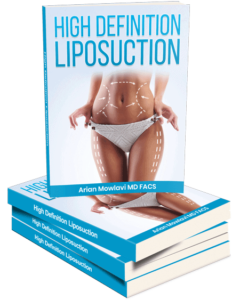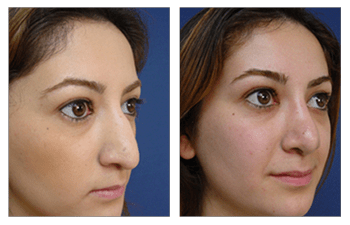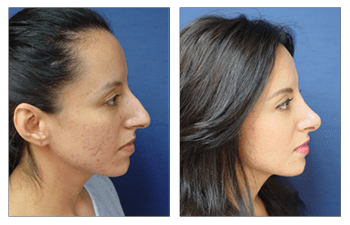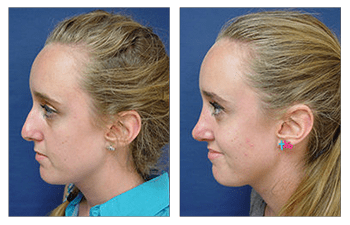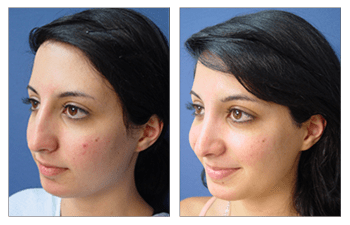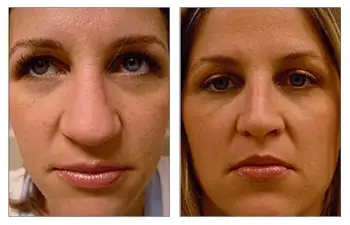WANT THE CONFIDENCE THAT COMES WITH
KNOWING YOU LOOK YOUR BEST?
Open Rhinoplasty
Nasal Tip Rhinoplasty by: Mirzania M.D.
Following nasal hump reduction, the second more frequent nasal contouring procedure sought involves improving the look of the nasal tip. When trying to access the nasal tip it is important for your surgeon to visualize the shape of your lower lateral cartilages.
Each of these cartilages looks like an umbrella or a modified boomerang as described above which then meet at the tip of the nose to provide what you see as the shape of your tip.
Patients seeking to improve their tip may feel that their tip is too wide or rounded in appearance which has been described by a variety of descriptions such as a "bulbous" or "platypus" tip (Figure 19).
This appearance is caused by several factors including:
- Obtuse middle crura bend or curvature
- Poor approximation of the two middle crura at the tip area, and/or
- Extraneous fat under the nasal skin

(Figure 19)
Thus treatment of a wide top should require correcting of one or all of the above deformities:
- A stitch can be placed to make the middle crural bend more acute called an intra-crural stitch
- A stitch can be placed between the two middle crura more closely approximating the bend structures and thus setting the dome/tip width and is called an intercrural stitch; and/o
- Defat the fat from the underlying soft tissue tip; this maneuver must be performed cautiously as to not compromise blood flow to the nasal tip cover.
In addition to narrowing and/or refining the nasal tip shape, it is paramount to set its position or height. There are certain proportions that must be kept in mind when altering the nasal tip structures and these include keeping the nasal tip as the lead point of the nasal dorsum.
This means that the nasal tip must be slightly higher than the nasal dorsum. For females, this nasal tip projection can be slightly more pronounced as depicted by a supratip break; in contrast, males should have a subtle tip lead (Figure 20).

(Figure 20)
Tip positioning is an extremely important consideration especially following open rhinoplasty, in which the tip must be appropriately supported as it will be pulled down during tissue healing that takes place along the columellar incision.
Your surgeon may use a variety of methods to reinforce the tip structure including tip set back on the anterior caudal septum, a floating columellar strut graph is ideal for male patients whose nasal length does not require adjusting and who only require a minimal tip lead on the nasal dorsum. Finally, the septal extension graph is ideal for female patients who have appropriate nasal length and desire a strong nasal tip lead.
The use of these maneuvers is also influenced by the nasolabial angle determined by the angle created by the vectors extending from the nasal base to the tip and the nasal base to the upper lip as seen on the lateral or profile view. In females, this angle should be more generous and approximate 100 to 105 degrees, in males, this angle is more closed and approximately 90 to 95 degrees (Figure 21).

(Figure 21)
The nasal tip reinforcement techniques described above will affect the nasolabial angle and must be chosen approximately. Additionally, the reinforcing techniques used above will further affect the nasal length to nasal projection ratios which should be maintained at a 3:1 length ratio (Figure 22).

(Figure 22)
Nasal Tip Anatomy Merzania M.D.
The nasal tip shape is created by the intimate contact of two boomerang-shaped cartilages called the lower lateral cartilages with each other and their underlying central structural pillar cartilage called the septum. The lower lateral cartilage has been divided into three segments called the lateral, middle, and medial crura.
The medial crura act as "accessory support beams" as they converge together within the columella, the name of the central, lowest part of the nose.

(Figure 9)
The medial crura compromise the bend portion of the boomerang and define the dome, i.e. tip of the nose. The nasal tip shape is determined by not only the middle crural bend but also by how the two middle crura of each side of the nose come together, the confluence of the two middle crura and the angle created by them translates into the dome and tip shape.
The tip shape can be blunted if the middle crural angles are obtuse or in patients who have excessive fat overlying the underlying cartilaginous infrastructure. Finally, the lateral crura extend laterally from the middle crura to the medial aspect of the cheek along the alar rims. The lateral crura help support the alar rims thereby keeping the nares, or nasal entryways open.

(Figure 10)
When looking up at the nose (termed the worm´s eye view), an equilateral triangle is optimal. This triangle is formed by the nasal base and toe slanted lines outlining the alar rims converging at the tip.
This triangle is bisected by the central structure called the Columella (Figure 9). The columella houses the converging medial crura that create the lowest component of the central pillar.
On the lateral view, the nasal alar rims should be just behind the columella (central) structure described above. A gentle ellipse should be able to be drawn between the offset of the alar rims from the columella. When the ellipse is wide, this is an indication of either retracted ala or prominent columella, when the ellipse is narrowed then this is an indication of droopy or overhanging alar rims or retracted columella. (Figure 10)
Finally, on the front view, the alar rims should lie within a vertical line dropping from the medial canthi. (Figure 11) Then the alar rims extend lateral to this line, then consideration for alar rim reduction should be considered.

(Figure 11)
Knowledge of the nasal tip infrastructure and current aesthetic standards will help you better convey the changes you are desiring to your surgeon. Conversely, this knowledge will help your surgeon communicate to you the maneuvers that he will be performing to refine your nasal tip shape.
Frequently Asked Questions:
Can a callus occur if I had closed rhinoplasty method and my nose wasn't broken but shaved?
Taping of the nose is critical to keep swelling down. When the tissues swell, proinflammatory cells are forbidden from entering the tissues; pro-inflammatory cells then recruit fibroblasts that deposit collagen which can then create scar tissue in your nose.
Scar tissue build-up is probably the number one cause of hump recurrence. Please listen to your doctor and comply with postoperative instructions. We don't just wing these decisions, they are based on decades of experience.
What procedure/process during rhinoplasty will cause a piggy nose tip and an overall shorter nose?
Tip rotation and shortening of the nose are maneuvers that are very well documented and performed when a long nose or a downturned tip needs to be rotated or nose shortened.
The ideal nasolabial angle which is the angle created by your tip and lip should be 105 degrees for the female and 95 degrees for the male. Of the three maneuvers, the middle crura to septal suture can create rotation.
Can I shave my dorsal bump down with local anesthesia?
Dorsal hump reduction can be easily performed without the need to go under general anesthesia. The reason for this is that when the top of the hump is removed with a rasp vs open surgery. This can be done with local anesthesia.
If you create an open roof deformity (the top of the hump is gone), then it requires breaking the bone at the base and moving the bones in. This surgery requires general anesthesia.
Patient-Specific Questions:
Can I get my silicone nose implant removed one month after rhinoplasty surgery?
Dorsal hump reduction can be easily performed for you but you do need to go under. The reason for this is that when the top of the hump is removed with a rasp (this can be done with you awake), you create an open roof deformity(the top of the hump is gone), then you need to break the bone at the base and move the bones in. the breaking of the bones to close the open roof requires anesthesi
Can I have a BBL, TT, lipo and rhinoplasty all at once?
Yes, you may have a Rhinoplasty, Tummy Tuck, and Brazilian Butt Lift at the same time. Just make sure that you choose your plastic surgeon carefully.
Rhinoplasty involving tip improvements requires an open rhinoplasty so make sure that your chosen nose surgeon is an expert of open rhinoplasties.
Optimal tummy tucks require specific surgical maneuvers that will establish waistline narrowing, proper muscle plication, low incision lines, and an innie belly button.
Best BBL results are achieved with Vaser liposuction which allows for sculpting and replacement of fat from unwanted to desired areas.
Broke my nose years ago. What should my next step be to fix it? (photo)
Your insurance will cover the correction of your crooked nasal dorsum but the tip aesthetics is considered elective so you will have to pay for this yourself. This is called a 50:50 case.
HOW OUR PATIENTS FEEL ABOUT US:
Mini tummy tuck, Vaser lipo
My experience has been so far excellent. I’m a mom of 4. All natural births. Been working out for 4 years. The idea of having a tummy tuck never came to mind, But impossible for me after having 4 kids and excess skin. Saw a few doctors that wanted to do a full tummy tuck. I wasn’t convinced. I came to see Mirzania and he was positive I was a perfect candidate for a mini TT! I was sold! I came to Dr. Paris because he is an artist in Vaser lipo. Not many are professionals and have the experience like he does. He gave me my hour glass shape, mini TT, took away my annoying flanks and added small bbl and small fat transfer to breast. Staff is amazing and I’m loving my progress. I started working out again at 6 weeks with no problems. It’s been 9 weeks and 4 days and I feel better everyday.
Pre & post-op
Up until 9 weeks. Every week getting better. Working out. Mini TT scar coming along great. Had a stubborn stitch- couldn’t see it but did some circle motion and pushed it back in. Doesn’t bother me anymore. Had another pop out, but I cut the edge, circle motion with lotion and went away. Stomach feels slightly tight and numbed, But doc said it’s normal, nerves needs to settle in and get used to new home. I’ve been able to walk straight after 2nd week of surgery. Wearing nightly thin girdle at night got from Nordstrom’s 35$ works great. . Wear it at times during day. Leonisa brand. Very comfy. Dr. M is an artist in body sculpting!
A Perfect Fit for Male Tummy Tuck and Lipo
A perfect fit. I am so happy that I found Dr. Paris. I was pretty heavy as a kid and got into fitness later in my 20s. But I always had the remnants of my former self lurking around, blocking me from seeing my complete results from training. I had always wanted to get a tummy tuck and high-def lipo but figured it was something way out of reach for me at this point.

